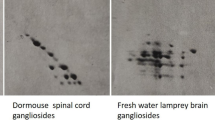Summary
The reaction of colloidal ferric oxide with sialomucins (Hale stain) was applied to sialic acid-containing gangliosides in subcellular fractions of the brain, in order to investigate their localization by electron microscopy. Prior to all experiments, a check was made, by means of tritium-labeled ganglioside, to confirm that the ganglioside content in the subcellular particles was not the result of an unspecific adsorption during the isolating procedure. No considerable unspecific adsorption could be registered. Hale stain was first applied to subcellular fractions obtained from guinea-pig brains. Since nerve-endings, mitochondria and synaptic vesicles gave a positive staining reaction, incubations with neuraminidase and hyaluronidase were carried out in order to achieve a differentiation. Finally, the method was applied to the membranous cytoplasmic bodies (MCB) which were isolated from the brain of a patient with Tay-Sachs disease. It was concluded that: a) Hale stain stains gangliosides also, b) gangliosides are localized in the membrane of membranous cytoplasmic bodies and also very probably in the membrane of nerve-endings, c) synaptic vesicles give a Hale-positive reaction which cannot with certainty be attributed to gangliosides, d) the outer membrane of mitochondria contains Hale-positive substances, the nature of which is not known.
Zusammenfassung
Die Reaktion von kolloidalem Eisen mit Sialomucinen (Hale stain) wurde zur elektronenmikroskopischen Darstellung der neuraminsäurehaltigen Ganglioside in den subcellulären Fraktionen des Gehirns angewandt. Zunächst wurde mit Hilfe tritiummarkierter Ganglioside überprüft, ob bei der Gewinnung subzellulärer Fraktionen Ganglioside nicht unspezifisch subcellulär adsorbiert werden. Eine nennenswerte Adsorption konnte ausgeschlossen werden. Das Verfahren wurde zuerst auf die aus Meerschweinchengehirnen isolierten Fraktionen angewandt. Da Nervenendigungen, Mitochondrien und Synapsenbläschen Hale-positiv reagierten, dienten Enzyminkubationen mit Neuraminidase und Hyaluronidase zur Differenzierung von anderen Hale-positiven sauren Substanzen. Schließlich wurde die Methode auf die cytoplasmatischen multilamellären Körperchen (MCB) übertragen, die aus Gehirnen an Tay-Sachs'scher Krankheit Verstorbener isoliert wurden. Aus den Versuchen konnte abgeleitet werden, a) daß die Hale-Färbung auch Ganglioside anfärbt, b) daß Ganglioside auf der Oberfläche der Membran von den multilamellären Körperchen und mit hoher Wahrscheinlichkeit auch auf der Membran der Nervenendigungen lokalisiert sind, c) daß die Synapsenbläschen eine positive Reaktion ergeben, die jedoch nicht mit Sicherheit auf vorhandene Ganglioside zurückgeführt werden kann, d) daß die äußere Mitochondrienmembran Hale-positive Substanzen enthält, deren Natur unbekannt ist.
Similar content being viewed by others
References
Burton, R. M., L. Garcia-Bunuel, M. Golden, andY. M. Balfour: Incorporation of radioactivity ofd-glucosamine-1-C14,d-glucose-1-C14,d-galactose-1-C14, andDl-serine-3-C14 into rat brain glycolipids. Biochemistry2, 580–585 (1963).
Curran, R. C., A. E. Clark, andD. Lovell: Acid mucopolysaccharides in electron microscopy. The use of the colloidal iron method. J. Anat. (Lond.)99, 427–434 (1965).
Dekirmenjian, H., andE. Brunngraber: Intracellular distribution of gangliosides and protein-bound sialomucopolysaccharides. Fed. Proc.25, 742 (1966).
Derry, D. M., andL. S. Wolfe: Ganglioside analyses of serial cryostat sections through Ammon's Horn and cerebellar folia. Exp. Brain Res.5, 32–44 (1968).
Eichberg, J., V. P. Whittaker, andR. M. C. Dawson: Distribution of lipids in subcellular particles of guinea-pig brain. Biochem. J.92, 91–100 (1964).
Folch, J., M. Lees, andG. H. Sloane Stanley: A simple method for the isolation and purification of total lipides from animal tissues. J. biol. Chem.226, 497–509 (1957).
Gasic, G., andL. Berwick: Hale stain for sialic acid-containing mucins. J. Cell Biol.19, 223–228 (1962).
Gielen, W.: Ein Serotonin- und Ca++-Receptor. Z. Naturforsch.21b, 1007–1008 (1966).
Hale, C. W.: Histochemical demonstration of acid polysaccharides in animal tissues. Nature (Lond.)157, 802 (1946).
Kishimoto, Y., W. E. Davies, andN. S. Radin: Turnover of the fatty acids of rat brain gangliosides, glycerophosphatides, cerebrosides, and sulfatides as a function of age. J. Lipid Res.6, 525–531 (1965).
Lapetina, E. G., E. F. Soto, andE. De Robertis: Gangliosides and acetylcholinesterase in isolated membranes of the rat-brain cortex. Biochim. biophys. Acta (Amst.)135, 33–43 (1967).
Mowry, R. W.: Improved procedure for the staining of acidic polysaccharides by Müller's colloidal (hydrous) ferric oxide and its combination with the Feulgen and the periodic acid-Schiff reactions. Lab. Invest.7, 566–576 (1958).
Radin, N. S., F. B. Martin, andJ. R. Brown: Galactolipide metabolism. J. biol. Chem.224, 499–507 (1957).
Rambourg, A., andC. P. Leblond: Electron microscope observations on the carbohydraterich cell coat present at the surface of cells in the rat. J. Cell Biol.32, 27–53 (1967).
Reynolds, E. S.: The use of lead citrate at high pH as an electronopaque stain in electron microscopy. J. Cell Biol.17, 208–212 (1963).
Samuels, S., S. R. Korey, J. Gonatas, R. D. Terry, andM. Weiss: Studies in Tay-Sachs disease. J. Neuropath. exp. Neurol.22, 81–97 (1963).
Spence, M. W., andL. S. Wolfe: Gangliosides in developing rat brain. Isolation and composition of subcellular membranes enriched in gangliosides. Canad. J. Biochem.45, 671–688 (1967).
Stahl, E., andU. Kaltenbach: Dünnschicht-Chromatographie. VI. Mitteilung. Spurenanalyse von Zuckergemischen auf Kieselgur G-Schichten. J. Chromatog.5, 351–355 (1961).
Suzuki, K.: Incorporation ofd-glucose-U-C-14 into gangliosides in a cell-free system. Biochem. biophys. Res. Commun.16, 88–93 (1964).
—, andS. R. Korey: Study on ganglioside metabolism. J. Neurochem.11, 647–653 (1964).
Whittaker, V. P., andM. N. Sheridan: The morphology and acetylcholine content of isolated cerebral cortical synaptic vesicles. J. Neurochem.12, 363–372 (1965).
Wiegandt, H.: Ganglioside. Ergebn. Physiol.57, 190–222 (1966).
— The subcellular localization of gangliosides in the brain. J. Neurochem.14, 671–674 (1967).
Woolley, D. W., andB. W. Gommi: Serotonin receptors, VII. Activities of various pure gangliosides as the receptors. Proc. nat. Acad. Sci. (Wash.)53, 959–963 (1965).
Author information
Authors and Affiliations
Rights and permissions
About this article
Cite this article
Halaris, A., Jatzkewitz, H. Electron histochemical demonstration of gangliosides in normal and Tay-Sachs brain tissue. Acta Neuropathol 13, 157–168 (1969). https://doi.org/10.1007/BF00687028
Received:
Issue Date:
DOI: https://doi.org/10.1007/BF00687028




